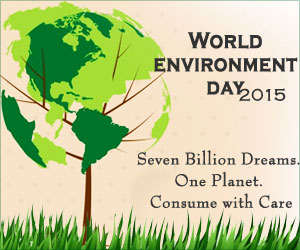Soaring pollution levels, crippling floods, quivering Richter notes to scores of environment laws awaiting implementation was India's environmental standing in 2015.

‘Soaring pollution levels, crippling floods, quivering Richter notes to scores of environment laws awaiting their implementation - this was India's environmental standing in 2015.’





Pollution surfaced in unexpected ways - like a lake in Bengaluru turning toxic and frothy with the industrial pollutants being mixed with the water. This incident caught not just national attention but that of the whole world. The country's northern part was known to have exceeded pollution levels at many times of the year, which should have triggered a 'red alert' had it been in another country, according to environment body Greenpeace. "If India had an air quality monitoring system as robust as that of Beijing, a large portion of north India would have been on red alert for as many as 33 days," the NGO said recently, pointing to the necessity to establish stronger air monitoring systems across the country.
Even before the start of winter, which usually greets the northern states with hazy skies and smog covered days, the entire belt of Punjab, Haryana, Delhi and Chandigarh choked in smoke due to the paddy field fires - the smoke which affected the country's climate even later for weeks, according to environmentalists.
But, according to Delhi-based environmentalist Vikrant Tongad, the year also saw the issue of air pollution being heard on a national and global level. Tongad said, "The year saw some initiatives which were much needed to be addressed: like methods of tackling air pollution, making clear India's stand to fight climate on a global level et al, but solutions for the issues still remain to be found."
He further added, "India never had such an 'active' stance at the crucial UN Climate Change Conference, in standing up for the developing countries, as it had this year at the 21st Conference of Parties (CoP 21) held in Paris, he said. There are however some gaps in the deal signed."
Advertisement
Indian interlocutors, who have been holding pride for introducing the terms 'sustainable lifestyle' and 'climate justice' to the preamble through Prime Minister Narendra Modi, have received criticism from the Center for Science and Environment (CSE) and other environment bodies for having no operational parts of these terms in the text, and hence no commitments.
Advertisement
As India made these commitments in Paris, the country's northern states remained fighting smog, while a majority of southern ones battled extreme untimely torrential rains that led to huge floods.
These rains, which lasted for over a week, lashed Chennai and other areas of Tamil Nadu and Andhra Pradesh. Besides drowning a major portion of Chennai in flood water, many parts of Tamil Nadu were severely affected due to flooding. These rains, which were the heaviest Tamil Nadu received in over a century left at least 169 people dead in the state, and 54 dead in Andhra Pradesh. With public transport, residences, office buildings and crops affected, Tamil Nadu has been struggling to get life back to normalcy.
Union Minister for Forests, Environment and Climate Change Prakash Javadekar termed the floods as 'not a part of climate change' and said that they were a 'localized event' and a 'natural calamity', which the environmental groups rejected. According to CSE, 'unregulated urbanization and climate change-induced extreme weather' were the reason behind the flood crisis in Tamil Nadu and other states.
But this year it was quite commendable to see Indian courts taking active stand in pushing for cleaner air and to act against pollution, Tongad added, referring to the Delhi High Court asking the Delhi government to take stricter steps to battle the city's pollution. "It seems we are living in a gas chamber," the court had said, asking the Delhi government and the Center to immediately act on reducing pollution in and around the capital.
The environment groups said, "The Supreme Court's recent decision to ban diesel vehicle registrations in the National Capital Region for three months and surrounding towns is also a much needed move, to fight a large amount of pollution caused by diesel vehicles."
Tongad said, "This step has brought the whole nation's attention to fighting for a clean environment." The National Green Tribunal said, "Following the Delhi High Court's orders, the Delhi government undertook the initiative in the capital to ration road space, allowing even and odd numbered vehicles to ply only on alternative days. But an initiative like this needs to be thought through, as it could lead to the people going for a second car."
Instead of having laws which safeguard environment, the current government's attempt to amend the environment laws so as to allow better investments and bigger companies to be housed in the country is a scary move, environment activists said.
According to Environment Support Group (ESG), a Bengaluru-based trust which works to safeguard environment, the Draft Environment Laws (Amendment) Bill 2015, dated October 7, 2015 (which could perhaps be presented before parliament in the budget session) allows the government to 'relax environment laws for better investments'.
"The draft, according to ESG, 'pushes laws through the backdoor', and has been proposed by private firms Ernst and Young and Amarchand and Mangaldas and Company, whose interests are majorly 'economical and environmental'", said Bhargavi S. Rao, coordinator of the ESG.
Rao further added, "The country has been regressive in the past few years in terms of environment law amendments taking away right to participation from the communities. We have brought down our standards in terms of pollution tackling. Amendments which are being proposed could bring a disaster to the country. The amendments itself are violating environment principles in the name of development."
Source-IANS










